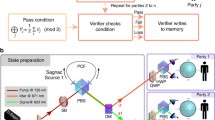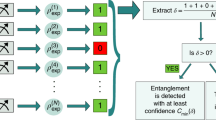Abstract
Quantum entanglement is an essential resource for quantum information processing, either for quantum communication or for quantum computation. The multipartite case of entanglement, especially the so called genuine multipartite entanglement, has significant importance for multipartite quantum information protocols. Thus, it is a natural requirement to experimentally verify multipartite quantum entanglement when performing many quantum information tasks. However, this is often technically challenging due to the difficulty of building a shared reference frame among all involved parties, especially when these parties are distant from each other. In this paper, we experimentally verify the genuine tripartite entanglement of a three-photon Greenberger-Horne-Zeilinger state without shared reference frames. A high probability 0.79 of successfully verifying the genuine tripartite entanglement is achieved when no reference frame is shared. In the case of sharing only one common axis, an even higher success probability of 0.91 is achieved.
摘要
量子纠缠在量子信息、量子通信及量子计算中均是一种重要的资源。多体纠缠, 尤其是真多体纠缠对于量子相对于经典信息处理的优势更具基本意义。在实现远距离量子通信或分布式量子计算等协议之前, 对制备的纠缠态进行纠缠性质的实验验证是十分重要且必要的。然而, 传统上使用Bell不等式验证纠缠的方法都要求得到纠缠粒子的各方在对粒子进行测量时选择共同的测量基矢组。这在大空间尺度分发纠缠态, 实现量子协议的实验中, 技术上是很难实现的, 需要耗费大量资源。本实验验证了一种类正四面体基矢组在不共享参考系的情形下, 对于检测真多体纠缠时具有很高的敏感性和成功概率。在3粒子情形下, 3方互相不共享任何参考方向时, 成功概率可达0.79;仅共享一个参考方向时, 成功概率甚至可达0.91。





Similar content being viewed by others
References
Bennett CH, Brassard G, Crépeau C (1993) Teleporting an unknown quantum state via dual classical and einstein-podolsky-rosen channels. Phys Rev Lett 70:1895–1899
Li TC, Yin ZQ (2016) Quantum superposition, entanglement, and state teleportation of a microorganism on an electromechanical oscillator. Sci Bull 61:163–171; Sci Bull 61:264 (E)
Barenco A, Ekert AK (1995) Dense coding based on quantum entanglement. J Mod Opt 42:1253–1259
Mattle K, Weinfurter H, Kwiat PG et al (1996) Dense coding in experimental quantum communication. Phys Rev Lett 76:4656–4659
Wei D, Yang X, Luo J et al (2004) NMR experimental implementation of three-parties quantum superdense coding. Chin Sci Bull 49:423–426
Brunner N, Cavalcanti D, Pironio S et al (2014) Bell nonlocality. Rev Mod Phys 86:419
Cabello A (2001) Bell’s theorem without inequalities and without probabilities for two observers. Phys Rev Lett 86:1911–1914
Hardy L (1993) Nonlocality for two particles without inequalities for almost all entangled states. Phys Rev Lett 71:1665–1668
Cavalcanti D, Acín A, Brunner N et al (2013) All quantum states useful for teleportation are nonlocal resources. Phys Rev A 87:042104
Yao C, Chen Z, Ma Z et al (2014) Entanglement and discord assisted entropic uncertainty relations under decoherence. Sci China Phys Mech Astron 57:1703–1711
Palsson MS, Wallman JJ, Bennet AJ et al (2012) Experimentally demonstrating reference-frame-independent violations of bell inequalities. Phys Rev A 86:032322
Shadbolt P, Vértesi T, Liang YC et al (2012) Guaranteed violation of a bell inequality without aligned reference frames or calibrated devices. Sci Rep 2:470
D’Ambrosio V, Nagali E, Walborn SP et al (2012) Complete experimental toolbox for alignment-free quantum communication. Nat Commun 3:961
Cao DY, Liu BH, Wang Z et al (2015) Multiuser-to-multiuser entanglement distribution based on 1550 nm polarization-entangled photons. Sci Bull 60:1128–1132
Su X, Jia X, Xie C et al (2014) Preparation of multipartite entangled states used for quantum information networks. Sci China Phys Mech Astron 57:1210–1217
Heilmann R, Gräfe M, Nolte S et al (2015) A novel integrated quantum circuit for high-order w-state generation and its highly precise characterization. Sci Bull 60:96–100
Borsten L, Dahanayake D, Duff MJ et al (2009) Freudenthal triple classification of three-qubit entanglement. Phys Rev A 80:032326
Borsten L, Dahanayake D, Duff MJ et al (2010) Four-qubit entanglement classification from string theory. Phys Rev Lett 105:100507
Coffman V, Kundu J, Wootters WK (2000) Distributed entanglement. Phys Rev A 61:052306
Mermin ND (1990) Extreme quantum entanglement in a superposition of macroscopically distinct states. Phys Rev Lett 65:1838–1840
Guo W, Fan D, Wei L (2015) Experimentally testing Bell’s theorem based on Hardy’s nonlocal ladder proofs. Sci China Phys Mech Astron 58:024201
Tóth G, Gühne O (2005) Detecting genuine multipartite entanglement with two local measurements. Phys Rev Lett 94:060501
Bovino FA, Castagnoli G, Ekert A et al (2005) Direct measurement of nonlinear properties of bipartite quantum states. Phys Rev Lett 95:240407
Walborn SP, Ribeiro PHS, Davidovich L et al (2007) Experimental determination of entanglement by a projective measurement. Phys Rev A 75:032338
Hofmann HF, Takeuchi S (2003) Violation of local uncertainty relations as a signature of entanglement. Phys Rev A 68:032103
Bertlmann RA, Zeilinger A (2002) Quantum (un) speakables: from bell to quantum information. Springer Science & Business Media
Bartlett SD, Rudolph T, Spekkens RW (2007) Reference frames, superselection rules, and quantum information. Rev Mod Phys 79:555–609
Wallman JJ, Liang YC, Bartlett SD (2011) Generating nonclassical correlations without fully aligning measurements. Phys Rev A 83:022110
Senel CF, Lawson T, Kaplan M et al (2015) Demonstrating genuine multipartite entanglement and nonseparability without shared reference frames. Phys Rev A 91:052118
Wallman JJ, Bartlett SD (2012) Observers can always generate nonlocal correlations without aligning measurements by covering all their bases. Phys Rev A 85:024101
Klöckl C, Huber M (2015) Characterizing multipartite entanglement without shared reference frames. Phys Rev A 91:042339
Collins D, Gisin N, Popescu S et al (2002) Bell-type inequalities to detect true n-body nonseparability. Phys Rev Lett 88:170405
Liang YC, Rosset D, Bancal JD et al (2015) Family of bell-like inequalities as device-independent witnesses for entanglement depth. Phys Rev Lett 114:190401
Liang YC, Harrigan N, Bartlett SD et al (2010) Nonclassical correlations from randomly chosen local measurements. Phys Rev Lett 104:050401
Kurtsiefer C, Oberparleiter M, Weinfurter H (2001) Generation of correlated photon pairs in type-II parametric down conversion-revisited. J Mod Optic 48:1997–2007
Zhang C, Huang YF, Wang Z et al (2015) Experimental greenberger-horne-zeilinger-type six-photon quantum nonlocality. Phys Rev Lett 115:260402
Acknowledgments
This work was supported by the National Natural Science Foundation of China (61327901, 61490711, 11274289, 11325419, 61225025, 11474268, and 11374288), the Strategic Priority Research Program (B) of the Chinese Academy of Sciences (XDB01030300), the National Youth Top Talent Support Program of National High-level Personnel of Special Support Program, and the Fundamental Research Funds for the Central Universities (WK2470000018).
Author information
Authors and Affiliations
Corresponding authors
Ethics declarations
Conflict of interest
The authors declared that they have no conflict of interest.
About this article
Cite this article
Wang, Z., Zhang, C., Huang, YF. et al. Experimental verification of genuine multipartite entanglement without shared reference frames. Sci. Bull. 61, 714–719 (2016). https://doi.org/10.1007/s11434-016-1063-5
Received:
Revised:
Accepted:
Published:
Issue Date:
DOI: https://doi.org/10.1007/s11434-016-1063-5




